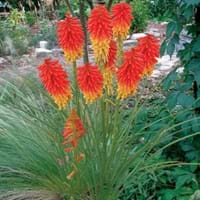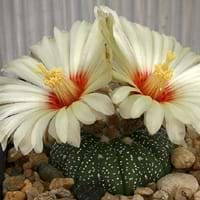Life Span
Perennial
Perennial
Type
Perennial
Cactus, Flowering Plants
Origin
Hybrid origin
Mexico, Texas
Types
Not Available
Not Available
Habitat
Damp Places, Marshy ground
Desert, In desert grasslands, Rocky areas
USDA Hardiness Zone
6-9
13-15
Sunset Zone
2a, 2b, 3a, 3b, 4, 5, 6, 7, 8, 9, 14, 15, 16, 17, 18, 19, 20, 21, 22, 23, 24
21,22,23,24
Habit
Clump-Forming
Oval or Rounded
Minimum Height
Not Available
Minimum Width
Not Available
Flower Color
Yellow, Red, Orange, Pink
Red, Yellow
Flower Color Modifier
Bicolor
Not Available
Fruit Color
Not Available
Green, Pale Pink
Leaf Color in Spring
Green, Blue Green
Not Available
Leaf Color in Summer
Green, Blue Green
Not Available
Leaf Color in Fall
Blue Green, Gray Green, Light Yellow
Not Available
Leaf Color in Winter
Light Green
Not Available
Leaf Shape
Linear
Not Applicable
Plant Season
Spring, Summer
Not Available
Sunlight
Full Sun, Partial Sun
Not Available
Growth Rate
Medium
Not Available
Type of Soil
Clay, Loam, Sand
Not Available
The pH of Soil
Acidic, Neutral
Not Available
Soil Drainage
Well drained
Not Available
Bloom Time
Early Summer, Summer
Not Available
Repeat Bloomer
No
Not Available
Tolerances
Drought
Not Available
Where to Plant?
Container, Ground
Ground
How to Plant?
Divison, Seedlings
Seedlings, Transplanting
Plant Maintenance
Medium
Medium
Watering Requirements
Needs more water during establishment, Water Deeply, Water in morning to avoid prompting diseases, Water in the early morning hours
Needs very little water
In Summer
Lots of watering
Lots of watering
In Spring
Moderate
Moderate
In Winter
Average Water
Average Water
Soil pH
Acidic, Neutral
Not Available
Soil Type
Clay, Loam, Sand
Not Available
Soil Drainage Capacity
Well drained
Not Available
Sun Exposure
Full Sun, Partial Sun
Not Available
Pruning
Cut or pinch the stems, Remove damaged leaves, Remove dead branches, Remove dead leaves
Remove damaged leaves, Remove dead branches, Remove dead leaves
Fertilizers
All-Purpose Liquid Fertilizer, Apply N-P-K
All-Purpose Liquid Fertilizer
Pests and Diseases
Onion thrips, Red blotch, Root rot
Dry root rot, Root mealy bugs
Plant Tolerance
Drought, Moisture
Drought
Flower Petal Number
Single
Not Available
Showy Fruit
No
Not Available
Edible Fruit
No
Not Available
Fragrant Flower
No
Not Available
Fragrant Fruit
No
Not Available
Fragrant Leaf
No
Not Available
Fragrant Bark/Stem
No
Not Available
Showy Foliage
No
Not Available
Showy Bark
No
Not Available
Foliage Texture
Coarse
Bold
Foliage Sheen
Matte
Not Available
Invasive
No
Not Available
Self-Sowing
No
Not Available
Attracts
Snails
pollinators
Allergy
Not Available
Not Available
Aesthetic Uses
Borders, Cottage Garden, Ground Cover
Beautification, Showy Purposes
Beauty Benefits
Not Available
Not Available
Environmental Uses
Air purification
Air purification
Medicinal Uses
Not Available
Not Available
Part of Plant Used
Not Available
Flowers
Other Uses
Not Available
Used as Ornamental plant
Used As Indoor Plant
No
Yes
Used As Outdoor Plant
Yes
Yes
Garden Design
Container, Cutflower, Mixed Border, Rock Garden, Wall
Not Available
Botanical Name
KNIPHOFIA 'Border Ballet'
Astrophytum asterias
Common Name
Tritoma, Wisley Blue Spring Starflower, Wisley Blue Springstar
Star Cactus, Sand Dollar Cactus
In Hindi
Tritoma
रेत डॉलर कैक्टस
In German
Tritoma
Sand Dollar Cactus
In French
Tritoma
Sand Dollar Cactus
In Spanish
tritoma
Sand Dollar Cactus
In Greek
tritoma
Sand Dollar Cactus
In Portuguese
Tritoma
Cacto do dólar de areia
In Polish
Tritoma
Sand Dollar Cactus
In Latin
Trytoma
Sand Dollar Cactus
Phylum
Tracheophyta
Magnoliophyta
Class
Magnoliopsida
Magnoliopsida
Order
Asparagales
Caryophyllales
Family
Liliaceae
Cactaceae
Genus
Kniphofia
Astrophytum
Clade
Angiosperms, Monocots
Angiosperms, Core eudicots, Eudicots
Tribe
Not Available
Cacteae
Subfamily
Not Available
Cactoideae
Properties of Tritoma and Sand Dollar Cactus
Wondering what are the properties of Tritoma and Sand Dollar Cactus? We provide you with everything About Tritoma and Sand Dollar Cactus. Tritoma doesn't have thorns and Sand Dollar Cactus doesn't have thorns. Also Tritoma does not have fragrant flowers. Tritoma has allergic reactions like Not Available and Sand Dollar Cactus has allergic reactions like Not Available. Compare all the properties and characteristics of these two plants. Find out which of these plant can be used as indoor plant. If you are interested to decorate your house and garden, find out aesthetic uses, compare them and select the plant which will beautify your surrounding. Along with beautification, try comparing medicinal and edible uses of Tritoma and Sand Dollar Cactus and you can choose the plant having best and most benefits.
Season and Care of Tritoma and Sand Dollar Cactus
Season and care of Tritoma and Sand Dollar Cactus is important to know. While considering everything about Tritoma and Sand Dollar Cactus Care, growing season is an essential factor. Tritoma season is Spring and Summer and Sand Dollar Cactus season is Spring and Summer. The type of soil for Tritoma is Clay, Loam, Sand and for Sand Dollar Cactus is Not Available while the PH of soil for Tritoma is Acidic, Neutral and for Sand Dollar Cactus is Not Available.
Tritoma and Sand Dollar Cactus Physical Information
Tritoma and Sand Dollar Cactus physical information is very important for comparison. Tritoma height is 45.70 cm and width 50.80 cm whereas Sand Dollar Cactus height is Not Available and width Not Available. The color specification of Tritoma and Sand Dollar Cactus are as follows:
Tritoma flower color: Yellow, Red, Orange and Pink
Tritoma leaf color: Green and Blue Green
Sand Dollar Cactus flower color: Red and Yellow
- Sand Dollar Cactus leaf color: Not Available
Care of Tritoma and Sand Dollar Cactus
Care of Tritoma and Sand Dollar Cactus include pruning, fertilizers, watering etc. Tritoma pruning is done Cut or pinch the stems, Remove damaged leaves, Remove dead branches and Remove dead leaves and Sand Dollar Cactus pruning is done Remove damaged leaves, Remove dead branches and Remove dead leaves. In summer Tritoma needs Lots of watering and in winter, it needs Average Water. Whereas, in summer Sand Dollar Cactus needs Lots of watering and in winter, it needs Average Water.





